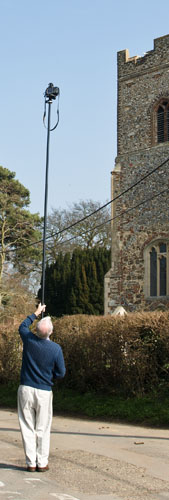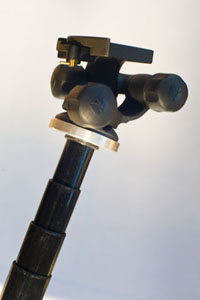 A light-weight telescopic mast for photography is relatively easy to create using one of the many telescopic banner poles available. Search the internet for a range of suitable options. many of these products are manufactured using fibreglass tubes, and it is essential to remove the thin and flexible upper sections before mounting a camera. Sections are typically about one metre in length, so a telescopic pole advertised as extending to ten metres might typically incorporate eight or ten sections. The top few sections are unlikely to be sufficiently robust to support a camera, and should be discarded. This might leave a five metre maximum extension.
A light-weight telescopic mast for photography is relatively easy to create using one of the many telescopic banner poles available. Search the internet for a range of suitable options. many of these products are manufactured using fibreglass tubes, and it is essential to remove the thin and flexible upper sections before mounting a camera. Sections are typically about one metre in length, so a telescopic pole advertised as extending to ten metres might typically incorporate eight or ten sections. The top few sections are unlikely to be sufficiently robust to support a camera, and should be discarded. This might leave a five metre maximum extension.

A camera can be attached relatively easily to the uppermost end of the pole. A suitable wood or metal plug, turned to the correct diameter, is inserted in to uppermost end of the hollow fibreglass tube and fixed securely in place with glue or a bolt. A tripod head can then be attached to the plug and used to position the camera.
A simple remote release system, either infrared or radio, can be used to release the camera's shutter. In the photograph on the left, the camera is about 15 or 16 feet above the ground but could have been raised another 6 or 8 feet in still conditions. A small radio receiver is plugged in to the camera's hot-shoe, and the button on the tiny transmitter is easily fired by the photographer.
Fibreglass poles are always somewhat flexible and become increasingly unstable as the extension increases. Consequently it is important to ensure that the base of the pole is anchored in some way before raising the camera more that a couple of metres overhead. This can be achieved using sand-bags or a suitable pin bolted in to the centre of a small plate on which the photographer places his or her feet. The base of the pole is then secure and the pole may be extended to five or six metres without difficulty. If the mast proves too flexible to achieve the required stability, three guy lines can be attached to the top of the pole and to suitable widely separated fixed points at ground level.






